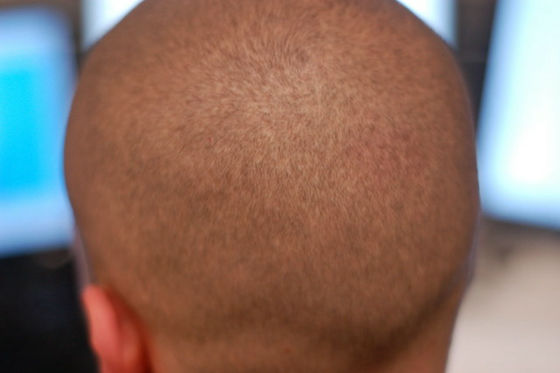'Stem cells' and '3D printing technology' are the keys to the recovery of bald head

by
While there are many different ways to treat thinning hair, current research has focused on stem cells and 3D printers.
A 'Cure' for Baldness Could Be Around The Corner-The Atlantic
https://www.theatlantic.com/health/archive/2019/07/hair-for-all/594826/
Therapeutic agents such as finasteride known under the trade name 'Propecia' and minoxidil marketed under the trade name 'Rogaine' are used as therapeutic agents for male pattern baldness (AGA) etc. because they have a hair growth effect. . These are medicines that have been used to treat thinning hair for decades, but they can not completely prevent hair loss or completely restore hair. In addition, these remedies are expensive and can not be used unless they can afford to pay as much as $ 44 per month.
Many scientists are continuing their research for the treatment of thinning hair, and it is announced in 2018 that research results can be made to prevent hair loss by smelling synthetic burdock in hair follicles . However, this is not 'treatment for thinning hair' but 'prevention for thinning hair', so it can not save those already suffering from thinning hair.

by
At the time of writing, the only solution to improve thinning is flocking. The human body produces a single hair from thousands of stem cells called dermal papillae at the base of each hair follicle . It is said that about 100,000 of these hair follicles exist on the human scalp, but as the dermal papilla disappears with the passage of time, the hair follicles become smaller and enter a dormant state. Therefore, although hair is still present on the scalp of a thin haired person, only very thin hair can be produced because the hair follicles are dormant.
Once the hair follicle goes into sleep, it can not recover. Therefore, when it comes to improving thin hair, it may be necessary to surgically transplant the whole hair follicle from another hairy scalp. This is flocking. In addition to costing about $ 10,000 (approximately ¥ 1,100,000) for flocking, a lot of healthy hair follicles need to be left on the scalp for transplantation. It seems that there are cases in which hair follicles other than the head (such as back and side) are transplanted together with the hair follicles, but such cases do not have an aesthetically pleasing finish.
In addition, there is a possibility of causing rejection after flocking.

by
Under these circumstances, the latest research is exploring methods using stem cell research and the latest printing technology using a 3D printer. In other words, a new hair transplantation technology is being explored in which human hair is replicated with a 3D printer and then planted on the scalp.
'For a long time, this kind of technology has been said to be ten years ahead,' said Robert Bernstein, a dermatologist specializing in hair transplantation, about hair transplantation using the latest 3D printers. But now we are approaching something more familiar. '
Using a 3D printer, it has also succeeded in outputting living cells such as blood vessels and viscera into a transparent gel, using human cells to create the heart, and creating skin and bones from living materials. You The hair is like a string of protein filaments wound around each other compared to what must function well in such a living being, and it is only necessary not to fall out of the scalp, so the output is very high. It is simple.

by
Stemson Therapeutics, a company that has already cloned hair follicles, has been launched to grow hair clones from stem cells derived from human skin and blood, contract the dermal papilla and hair follicles, and enter a dormant state. I am trying to transplant to a dead hair follicle.
Jeff Hamilton, a member of Stemson Therapeutics, said during the International Conference on Stem Cell Research (ISSCR) that he succeeded in transplanting human hair follicles into mice, which he said was taken Image of. You can check how the skin of the mouse looks like human hair.

In addition, the shape of the hair root seems to be an important factor to grow the hair to stretch in the same direction. When a CEO of Hamilton CEO Alexei Tereschiff transplanted a clone of a human hair follicle into a mouse several years ago, it grew in a different direction (body or oblique) from what the hair intended. . From this, it is predicted that simply transplanting the cloned hair follicles will cause the hair to grow at different angles, and the hair may look unnatural.
Therefore, there is a need to develop a hair follicle that can maintain its shape, and Hamilton proposes a solution in the 2019 ISSCR. The method is to create an artificial skeleton and place it around cloned hair follicles to directly support hair growth. Although he does not reveal the details of this artificial skeleton, he has announced that he has developed it in partnership with pharmaceutical company Allergan. In addition, he said that clinical trials of clonal hair follicle transplantation using this artificial skeleton will start within one and a half years.
Angela Christiano, who is a dermatology professor at Columbia University, in order to transplant hair follicles and dermal papilla separately on the skin, the United States of jelly confectionery, Jell-O type, such as, to be output using the 3D printer Successful. The research results have been reported in the science journal Nature Communications, and are described as 'innovating medical treatment such as various types of alopecia and chronic wounds.'
However, “Creating custom-made 3D printing molds means that they become tremendously expensive,” notes The Atlantic, and as technology advances, costs drop. However, it is still a long way off to get hair reproduction with a 3D printer at an affordable price.
Related Posts:
in Science, Posted by logu_ii







